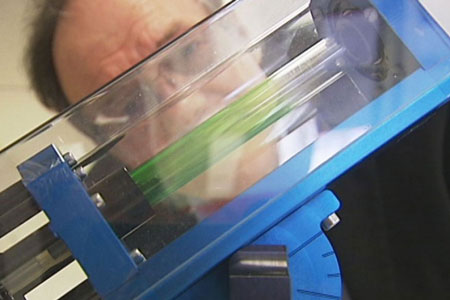| Posted: Mar 11, 2016 |
'Unboil an egg' machine could find nanotechnology applications
(Nanowerk News) A machine that can "unboil" an egg by unravelling its proteins can also cut through incredibly strong carbon nanotubes, creating huge potential for new electronics and drugs.
|
|
Professor Colin Raston from Adelaide's Flinders University invented the vortex fluidic device (VFD) after a eureka moment on a trans-Pacific flight.
|
|
Carbon nanotubes were considered revolutionary when developed 40 years ago, but their potential stalled because they were hard to work with.
|
|
Professor Raston figured out that the egg unboiler can also slice carbon nanotubes into precise length, when combined with water, a solvent and lasers.
|
 |
| Professor Colin Raston's vortex fluidic device.
|
|
Carbon nanotubes are 200 times stronger than steel, and conduct electricity five times better than copper.
|
|
"[They are] like a bit of spaghetti so it's got to be coiled up properly. If it's not they stick together and they stick to everything so they're very difficult to purify," Professor Raston said.
|
|
To cut carbon nanotubes, scientists normally have to use complex oxidation procedures and dangerous chemicals, which produce random-sized pieces.
|
|
But the VFD can cut them to an average length of 170 nanometres, making them far easier to deploy in medicine and electronics.
|
|
The development of the VFD last year earned Professor Raston a famed Ig Nobel prize.
|
|
Potentially game-changing applications
|
|
Professor Raston said it was a "contradiction" that the super-strong carbon nanotubes could be modified so simply.
|
|
"To take an exceptionally strong material and yet be able to cut it in a liquid without heating - that's what the VFD can do," he said.
|
|
Professor Raston said the process took only minutes and it had a wide range of potential applications.
|
|
"They range from chemistry to physics, possibly to mineral processing, food processing, biochemistry, medicine and if you think about it there's 10,000 universities in the world so there is a market for just selling it as a research tool," he said.
|
|
"We have our tablets and we have our iPhones and they're full of heavy metals, they're full of some metals that are probably rapidly approaching supply chain issues, they're being used up.
|
|
"So why not redevelop technologies based on carbon?"
|
|
PhD student Kasturi Vimalanathan played a key role in developing the VFD's internal cutting process.
|
|
"We are now investigating the wide range of commercial possibilities for the precision-cut nanotubes," she said.
|
|
Ms Vimalanathan said they could be used in solar panels, targeted cancer drugs or advanced electronics.
|
|
Flinders University collaborated with Curtin University, the Australian Nuclear Science and Technology Organisation, and the universities of Cincinatti and Missouri-Columbia in the United States.
|

